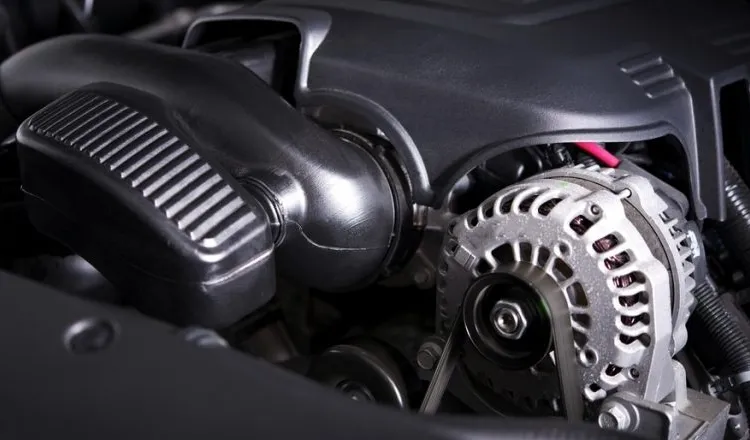The alternator, a crucial component in a car’s electrical system, plays a pivotal role in transmitting the electrical energy necessary for the engine and other vehicle components to function effectively. Amidst its various responsibilities, the alternator must operate within a stable voltage range to ensure optimal performance. Here, the alternator voltage regulator steps in to maintain this delicate balance, preventing fluctuations that could prove detrimental to the vehicle’s electrical system.
Points to consider:
- Function of the Alternator: The alternator’s primary function is to generate electrical power to support the vehicle’s electrical systems and recharge the battery during operation.
- Voltage Stability: Voltage changes naturally occur while driving due to factors such as power consumption, engine speed, and demand. Unchecked, these fluctuations could pose risks to the battery and the entire electrical installation.
- Importance of a Voltage Regulator: The voltage regulator acts as a crucial control mechanism, ensuring that the electrical output from the alternator remains stable and within the desired range. Without it, the vehicle could be susceptible to short circuits and even spontaneous combustion in extreme cases.
The alternator voltage regulator is, therefore, indispensable in maintaining the stability of the electrical system. Imagine the scenario where the correct voltage is 14V; sudden spikes or drops could expose the vehicle to potential hazards. The regulator, operating in tandem with the alternator, strategically modulates the excitation current, effectively stabilizing the voltage at the level required by the vehicle. This meticulous regulation ensures the longevity and efficiency of the entire electrical system, safeguarding it against the dangers posed by erratic voltage fluctuations.
In essence, the alternator voltage regulator acts as a vigilant guardian, overseeing the delicate dance of electrical energy within the vehicle, allowing it to function smoothly, and preventing potentially catastrophic consequences. It is this regulatory role that elevates the voltage regulator to a status of utmost importance within the intricate web of a car’s electrical architecture.
Symptoms of a Damaged Alternator Voltage Regulator
The alternator voltage regulator is a vital component in a car’s electrical system, and being a consumable part, it’s crucial to recognize signs of potential damage. Here are some key symptoms that indicate a damaged alternator voltage regulator:
- Charging Light on the Dashboard:
One of the primary indicators of a faulty voltage regulator is the illumination of the charging light on the dashboard. This light usually appears when starting the vehicle or while driving, serving as an early warning sign of potential issues. - Dimly glowing indicators:
In addition to the charging light, other dashboard indicators may exhibit a faint glow. This dimness suggests a lack of power reaching the electrical components, hinting at a potential problem with the alternator voltage regulator. - Lack of Current While Driving (Too Low Charging Voltage):
A significant symptom of a damaged regulator is a shortage of current while driving, leading to insufficient charging voltage. This can adversely affect the performance of various electrical systems in the car. - Sulfur Smell: Warning of Battery Overcharging:
Another distinctive sign of alternator voltage regulator damage is the presence of a sulfur smell. This odor results from overcharging the battery, and if ignored, it can lead to severe damage to the vehicle’s electrical installation.

Identifying these symptoms promptly is crucial to preventing further damage and ensuring the continued functionality of the alternator and associated electrical components. If any of these signs are noticed, it is advisable to conduct a thorough diagnosis using a voltage meter to assess the regulator’s performance under various conditions.
Understanding the Repair Process
The alternator voltage regulator, a crucial component in a car’s electrical system, is a consumable element that requires careful attention to ensure optimal performance. Recognizing the symptoms of a damaged regulator is the first step in understanding the repair process.
Signs indicating potential damage:
- Charging Light on the Dashboard: One of the initial indicators of a faulty voltage regulator is the illumination of the charging light on the dashboard, particularly during engine start or while driving.
- Dimly Glowing Indicators: Dimly glowing dashboard indicators also suggest a lack of power, signaling a potential issue with the alternator voltage regulator.
- Lack of Current While Driving: Insufficient charging voltage during operation can lead to a lack of current while driving, adversely affecting the overall electrical system.
- Sulfur Smell: A distinctive sulfur smell is a warning sign of battery overcharging. Ignoring this odor could result in severe damage to the vehicle’s electrical installation.
Understanding the repair process:
Once these symptoms are identified, it’s crucial to undertake a thorough diagnosis using a voltage meter. This diagnostic tool helps check the flow of current between the alternator and the regulator and assesses voltage levels during engine start and various operating conditions.
- Checking Current Flow: Begin by verifying the current flow between the alternator and the regulator. This preliminary check helps identify any interruptions or irregularities in the electrical connection.
- Voltage Checks: With the engine running, perform voltage checks on both the regulator and the battery. Engage another person to manipulate various electrical components, such as turning on lights, air conditioning, and the radio. Any fluctuations in voltage during these maneuvers indicate potential issues with the regulator.
- Data Variations: Note variations in data depending on factors like engine speed, load, and power consumption. Consistent irregularities in these readings suggest that the regulator requires replacement.
Qualification for replacement:
If the voltage meter reveals consistent irregularities, the alternator voltage regulator likely needs replacement. Timely replacement is crucial to prevent further damage to the electrical system and avoid safety risks.
Understanding these diagnostic steps empowers car owners to make informed decisions about the repair process, ensuring that only the necessary components are replaced. Regular checks and a proactive approach to addressing voltage regulator issues contribute to the overall longevity and reliability of the vehicle’s electrical system.
Step-by-Step Guide to Replacing the Alternator Voltage Regulator
Replacing the alternator voltage regulator is a manageable task with the right tools and a systematic approach. Here’s a step-by-step guide to ensure a smooth replacement process:
- Prepare the Necessary Tools:
- Before starting, gather the tools required for the replacement, including a voltage meter, screwdrivers, and wrenches.
- Ensure the car is parked in a safe and well-lit area with sufficient space to work.
- Disconnect Battery Terminals and Generator Belt:
- Begin by disconnecting the battery terminals to ensure safety during the replacement.
- Loosen and remove the generator belt from the alternator, allowing for easier access to the regulator.
- Unscrew the Alternator Housing:
- Locate the alternator housing, which houses the voltage regulator.
- Carefully unscrew the housing, exposing the voltage regulator for inspection and replacement.
- Access the Voltage Regulator:
- Identify the position of the voltage regulator within the alternator housing.
- Depending on the car model, the regulator may be easily accessible or may require some additional dismantling.
- Use a voltage meter for diagnosis:
- Employ a voltage meter to check the current flow between the alternator and the voltage regulator.
- During engine start, measure the voltage on both the regulator and the battery.
- Enlist the help of another person to manipulate variables such as engine speed and electrical load, observing any variations in data.
- Determine Qualification for Replacement:
- Analyze the voltage meter readings, focusing on discrepancies that indicate irregularities in voltage stabilization.
- If the data exhibits variations based on speed or load, it is a strong indication that the regulator requires replacement.
- Remove and Replace the Voltage Regulator:
- Once the need for replacement is confirmed, proceed to remove the old voltage regulator.
- Unfasten any screws or bolts securing the regulator in place and carefully disconnect it from the alternator.
- Estimate the Cost of a New Voltage Regulator:
- Research the cost of a new voltage regulator, keeping in mind that prices typically range from 12.59 usd to 125.87 usd .
- Consider variations in cost based on the specific car model.
- Install the new voltage regulator:
- Place the new regulator into the alternator housing, securing it with screws or bolts.
- Ensure a snug fit, and connect any necessary wiring according to the manufacturer’s instructions.
- Reattach the Alternator:
- Reattach the alternator housing, securing it back in place.
- Reinstall the generator belt and reconnect the battery terminals.
- Test the Replacement:
- Start the engine and use the voltage meter to verify that the new regulator effectively stabilizes the voltage.
- Monitor dashboard indicators for any signs of irregularities.
- Seek Professional Help for Advanced Cars:
- For more technically advanced cars, where the alternator removal process may be complex, it’s advisable to consult specialists.
- Before opting for a complete alternator replacement, ensure a thorough diagnosis to avoid unnecessary expenses.
Following these steps ensures a comprehensive guide to replacing the alternator voltage regulator, promoting the longevity and efficient performance of your vehicle’s electrical system.
Considerations for Advanced Cars
As automotive technology advances, some vehicles come equipped with more sophisticated electrical systems. For such advanced cars, the process of alternator voltage regulator replacement may demand additional technical expertise. It’s crucial to recognize the intricacies involved and, in certain cases, entrust the task to specialists who are well-versed in the complexities of modern automobile engineering.
Consider the following points when dealing with alternator voltage regulator replacement in technologically advanced cars:
- Technical Complexity: In highly advanced vehicles, the alternator and its associated components might be integrated into a more complex system. Removing the alternator to access and replace the voltage regulator may require a higher level of technical proficiency. It is advisable to assess whether the task aligns with personal DIY capabilities or necessitates professional intervention.
- Specialized Skills: Some modern cars incorporate cutting-edge technologies that may be beyond the scope of general automotive maintenance. If unsure about the complexity of the alternator voltage regulator replacement, seeking assistance from specialists is a prudent choice. They possess the expertise to navigate the intricate electrical systems and ensure a precise replacement process.
- Diagnostic Precision: Identifying issues in technologically advanced vehicles requires a thorough understanding of their intricate systems. Mechanics dealing with such cars should be adept at accurately diagnosing alternator voltage regulator problems. This includes differentiating between symptoms of regulator damage and potential issues with other electrical components.
- Caution Against Unnecessary Replacements: With advanced cars, there might be a tendency for some mechanics to recommend replacing the entire alternator as a shortcut solution. However, it’s essential for car owners to be aware of the symptoms of voltage regulator damage and advocate for a targeted replacement. Unnecessary alternator replacements can lead to additional costs without addressing the root cause of the issue.
In conclusion, while modern cars offer enhanced features and performance, their intricate electrical systems demand a cautious approach when dealing with alternator voltage regulator issues. By recognizing the specialized requirements of advanced vehicles and seeking expert assistance when needed, car owners can ensure the effective maintenance and repair of their sophisticated automobiles.’


